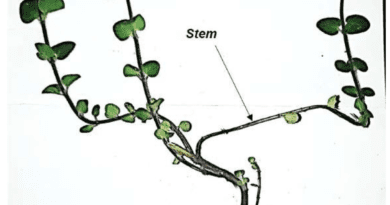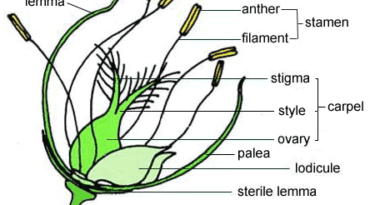Economic Importance, Uses, and By-Products of Oil Palm Roots
Oil palm roots refer to the underground part of the oil palm tree (Elaeis guineensis), which is a species highly valued for its oil-rich fruits. The root system of an oil palm consists of various types of roots that serve different functions in the tree’s growth and nutrient uptake.
The oil palm begins its growth with a taproot, which emerges from the germinating seed. The taproot extends vertically into the soil and serves as the primary anchor for the tree, providing stability and support.
From the taproot, numerous lateral roots branch out horizontally in different directions. These lateral roots spread out extensively in the topsoil, primarily in the upper 30 centimeters (12 inches) of soil. They form a dense network that aids in the absorption of water, minerals, and nutrients from the soil.
Oil palm trees also develop adventitious roots, which are additional roots that form from non-root tissues, such as the lower stem or the base of the trunk. These roots help with anchoring the tree and provide supplementary nutrient uptake.
The fine, fibrous roots of oil palm are abundant in number and make up the majority of the root system. These roots are thin, hair-like structures that grow from the lateral and adventitious roots. They spread extensively in the topsoil, increasing the tree’s ability to extract water and nutrients from the soil.
Oil palm roots have a significant role in water and nutrient uptake for the tree. Their dense network facilitates the absorption of water from the soil, ensuring the tree’s hydration even in dry conditions. The roots also uptake essential minerals and nutrients, including nitrogen, phosphorus, potassium, and trace elements necessary for the oil palm’s growth and productivity.
It’s important to note that oil palm roots can extend over a considerable area, often reaching a radius of 1.5 to 2 times the tree’s canopy diameter. This extensive root system helps the tree access resources efficiently and enhances its ability to withstand wind and other environmental stresses.
Understanding the characteristics and functions of oil palm roots is crucial for the cultivation and management of oil palm plantations, as it aids in optimizing nutrient management, irrigation practices, and overall tree health.
Economic Importance, Uses, and By-Products of Oil Palm Roots

Oil palm roots have several economic importance and uses. Here are some of them along with examples:
1. Soil stabilization: Oil palm roots play a crucial role in soil stabilization, preventing erosion and landslides. The extensive root system of oil palm helps bind the soil together, especially on slopes and riverbanks, reducing the risk of soil erosion.
2. Nutrient cycling: The roots of oil palm trees contribute to nutrient cycling in the soil. They absorb nutrients from the soil and transport them to the above-ground parts of the tree, promoting healthy growth. As the oil palm roots die and decompose, they release nutrients back into the soil, supporting the growth of other plants in the ecosystem.
3. Water absorption: Oil palm roots have a high capacity to absorb water from the soil. This is particularly important in areas with limited water availability or during dry periods. The ability of oil palm roots to efficiently extract water from the soil makes it a suitable crop in regions with water constraints.
4. Medicinal and herbal uses: Certain parts of oil palm roots have been traditionally used in herbal medicine. For example, oil palm root decoctions or infusions have been used to treat various ailments, including diarrhea, dysentery, fever, and stomach issues. These medicinal uses have cultural and economic significance in some regions.
5. Organic fertilizer: The roots of oil palm can be utilized as a source of organic fertilizer. When the oil palm roots are pruned or removed, they can be composted or processed to create organic fertilizer. This fertilizer can be used in oil palm plantations or in other agricultural systems, contributing to improved soil fertility and crop productivity.
Read Also : Puppies Grooming and Complete Care Guide
6. Research and biotechnology: Oil palm roots are of interest to researchers and biotechnologists. Studies on root architecture, physiology, and genetic traits of oil palm roots can lead to the development of improved varieties with enhanced productivity, disease resistance, and drought tolerance. Such advancements can benefit the oil palm industry and agricultural practices as a whole.
7. Bioremediation: Oil palm roots have the potential for bioremediation, which is the use of living organisms to remove or neutralize pollutants from contaminated soil or water. The deep and dense root system of oil palm trees can help absorb and break down certain contaminants, making it a potential tool for environmental cleanup in areas affected by pollutants.
8. Soil improvement: Oil palm roots can improve the structure and fertility of soil. Their penetration and growth help in loosening compacted soil, enhancing aeration, and promoting better water infiltration. This can be particularly beneficial in areas with degraded soils, where oil palm cultivation can contribute to soil restoration and increased agricultural productivity.
9. Erosion control and riverbank protection: Oil palm roots are effective in stabilizing riverbanks and reducing soil erosion along water bodies. The dense network of roots helps anchor the soil, preventing erosion caused by water currents and protecting riverbanks from degradation. This is particularly important in areas where rivers and waterways are prone to erosion, ensuring the ecological and economic integrity of watercourses.
10. Livelihood support: The cultivation of oil palm, including its roots, provides livelihood opportunities for millions of people in regions where oil palm is grown. From smallholder farmers to plantation workers, various stakeholders are engaged in oil palm cultivation and its related activities, contributing to local economies and rural development. The utilization of oil palm roots, such as for organic fertilizer production or traditional medicine, can further diversify income sources for communities.
11. Carbon sequestration: Oil palm roots, like other plant roots, play a role in carbon sequestration by storing carbon in the soil. The extensive root system of oil palm trees contributes to carbon sequestration, helping to mitigate climate change by reducing the concentration of greenhouse gases in the atmosphere.
12. Biogas production: Oil palm roots can be utilized as a feedstock for biogas production. Biogas is a renewable energy source produced through the anaerobic digestion of organic materials. By using oil palm roots as a substrate, biogas can be generated, which can then be converted into electricity, heat, or used as a cooking fuel. This provides an additional avenue for renewable energy production and reduces dependence on fossil fuels.
13. Land reclamation: Oil palm roots can be used in land reclamation projects. In areas where land has been degraded or abandoned due to mining, construction, or other activities, the planting of oil palm trees can help restore the land’s fertility and stability. The extensive root system helps in the formation of soil structure, enhances nutrient cycling, and promotes vegetation growth, thereby facilitating land recovery and utilization.
14. Wildlife habitat: The extensive root system of oil palm trees creates underground habitats that can provide shelter and resources for various soil-dwelling organisms, including beneficial insects, earthworms, and microorganisms. This supports biodiversity and ecological balance within oil palm plantations, contributing to the overall sustainability and resilience of the ecosystem.
15. Soil erosion prevention in coastal areas: Oil palm roots can help mitigate soil erosion in coastal regions. Coastal areas are often vulnerable to erosion due to tidal action and wind. The cultivation of oil palm, with its strong root system, can act as a protective barrier, preventing soil erosion and maintaining the integrity of coastal landscapes.
16. Byproduct utilization: While the primary focus of oil palm cultivation is on the fruits and oil extraction, the roots can be utilized as a byproduct. They can be used as animal feed or processed into value-added products such as root extracts for the cosmetic or pharmaceutical industries. This maximizes the utilization of oil palm resources and adds value to the overall palm oil production chain.
It is worth noting that the economic importance and uses of oil palm roots can vary depending on regional practices, cultural contexts, and specific needs of different industries. The sustainable management of oil palm cultivation, including the roots, is essential to ensure its economic benefits are balanced with environmental conservation and social considerations.
The Products and By-products That Can Be Derived From Oil Palm Roots

Oil palm roots primarily serve as an anchor for the oil palm tree and aid in nutrient absorption. While the main economic value of oil palm lies in its fruits, various products and by-products can be derived from different parts of the tree, including the roots. Here are some of the potential products and by-products that can be derived from oil palm roots:
1. Essential oils: Oil palm roots can be used to extract essential oils with various applications. These oils often possess aromatic properties and can be used in perfumes, soaps, candles, and other cosmetic products. They can also be used in aromatherapy or as natural insect repellents.
Example: Oil palm root essential oil is obtained through steam distillation and can be used in fragrance manufacturing or as an ingredient in personal care products.
Read Also : Economic Importance, Uses, and By-Products of Grape Internodes
2. Traditional medicine: In some traditional medicine practices, oil palm roots are used for their potential health benefits. They may be used in herbal remedies or traditional healing practices to treat various ailments.
Example: In certain regions, oil palm root extracts are used in traditional medicine to relieve digestive issues or as an anti-inflammatory agent.
3. Animal feed: Oil palm roots can be processed and used as a component in animal feed formulations. They provide a source of fiber and certain nutrients, making them suitable for livestock, such as cattle or poultry.
Example: Dried and ground oil palm roots can be mixed with other ingredients to produce animal feed pellets, which contribute to the nutritional requirements of livestock.
4. Organic fertilizer: Oil palm roots can be converted into organic fertilizer through composting or other decomposition processes. The resulting fertilizer can be utilized in agricultural practices to enhance soil fertility and plant growth.
Example: Chopped oil palm roots are mixed with other organic materials like leaves and composted to produce nutrient-rich organic fertilizer for use in gardens or crop cultivation.
5. Biomass fuel: Oil palm roots, along with other oil palm biomass residues, can be utilized as a source of renewable energy. They can be converted into biomass pellets, briquettes, or used directly as fuel in biomass power plants or for heating purposes.
Example: Chipped oil palm roots can be compressed into pellets and used as a sustainable energy source for industrial boilers or residential heating systems.
6. Biochar: Oil palm roots can also be used to produce biochar, a type of charcoal that is created through pyrolysis (high-temperature decomposition in the absence of oxygen). Biochar has applications in soil improvement, carbon sequestration, and water filtration.
Example: Oil palm roots are subjected to pyrolysis, resulting in the production of biochar. The biochar can be used to improve soil quality and increase water retention in agricultural fields.
7. Biogas production: Oil palm roots, along with other biomass residues, can be utilized in anaerobic digestion processes to produce biogas. Biogas is a renewable energy source that can be used for electricity generation or as a cooking fuel.
Example: Oil palm roots are collected and mixed with other organic waste in anaerobic digesters, where bacteria break down the biomass and produce biogas that can be utilized for various energy needs.
10. Biopolymers: Oil palm roots contain starch, which can be extracted and processed to produce biopolymers. Biopolymers have applications in the manufacturing of biodegradable plastics, packaging materials, and other industrial products.
Example: Starch extraction from oil palm roots involves grinding and washing the roots, followed by separation and drying of the starch. The extracted starch can then be used as a raw material for biopolymer production.
11. Tannins: Oil palm roots contain tannins, which are natural compounds with astringent properties. Tannins have various applications in industries such as tanning, leather production, and wood preservation.
Example: Oil palm root tannins can be extracted through a process involving maceration or solvent extraction. The extracted tannins can be used in leather processing or as a wood preservative.
12. Water purification: Oil palm roots have the potential to be used in water treatment processes due to their ability to adsorb contaminants. They can be utilized in water filtration systems or as a component in the production of activated carbon for water purification purposes.
Example: Dried and powdered oil palm roots can be packed into filtration units or incorporated into activated carbon production to remove impurities from water sources.
13. Soil erosion control: Oil palm roots, along with other oil palm biomass residues, can be used for soil erosion control. The roots can be used in soil bioengineering techniques such as live fascine or brush layering to stabilize soil and prevent erosion.
Example: Oil palm roots are strategically placed in erosion-prone areas and integrated into soil bioengineering structures to reinforce soil stability and prevent erosion.
These are just a few examples of the potential products and by-products that can be derived from oil palm roots. The utilization of these resources can contribute to waste reduction, promote sustainability, and create additional value from the oil palm industry.
Read Also : Products That Can Be Derived From Liquid Wastes









